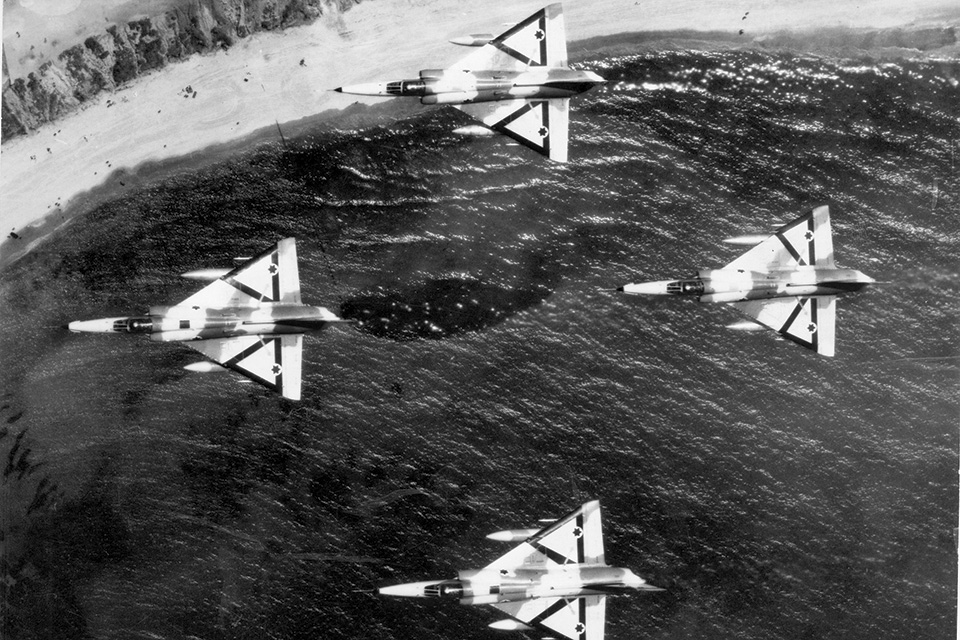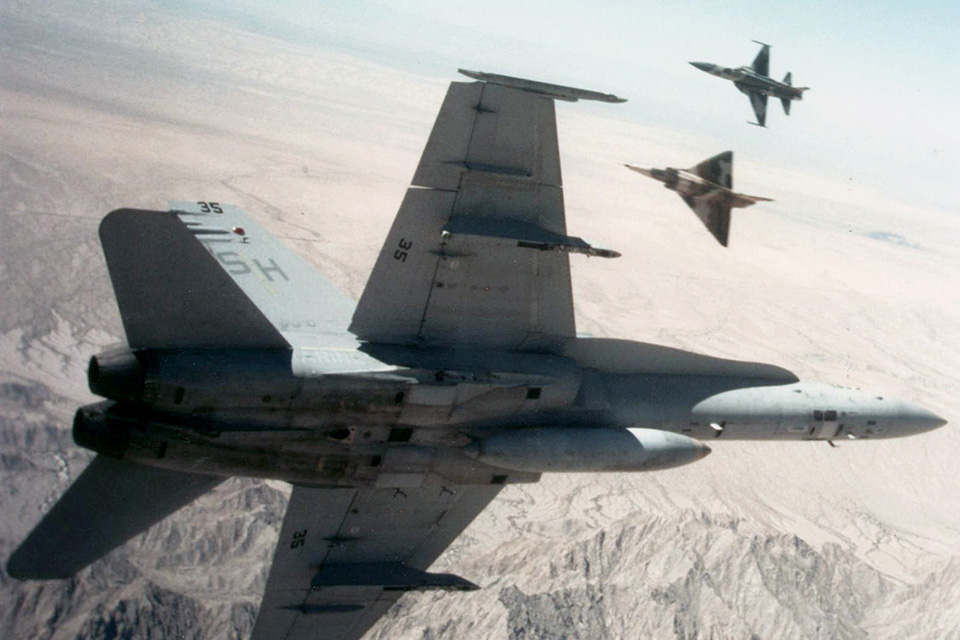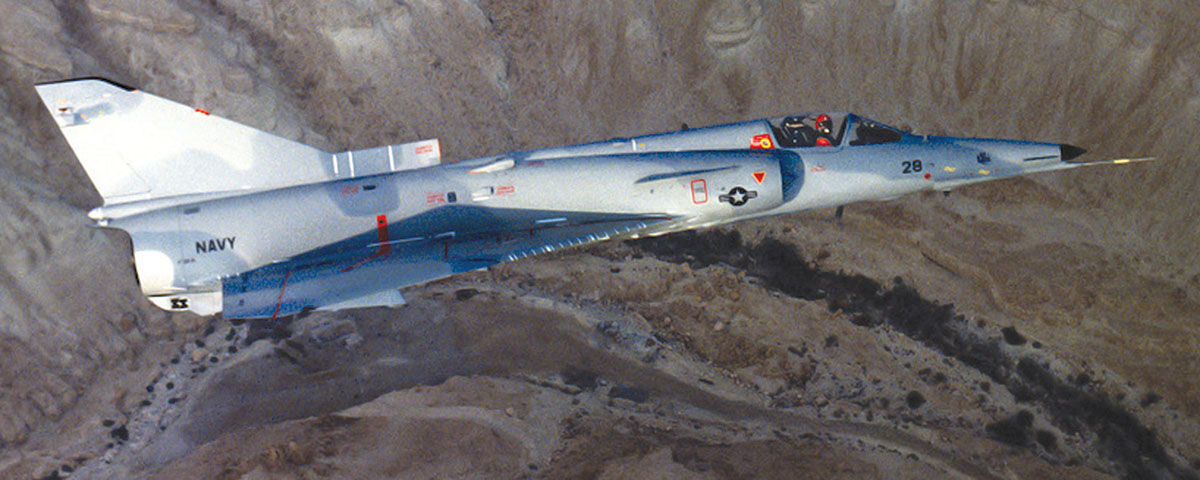The F-21 proved its mettle in countless dogfights against U.S. Navy and Marine Corps fighters.
Many Americans would be surprised to learn that during the latter half of the 1980s Israeli fighter aircraft regularly engaged in air-to-air combat with U.S. Navy and Marine Corps F-14s and F/A-18s. It was all part of peacetime training exercises, of course, in which the F-21A Lion, as the Americans had designated Israel Aircraft Industries’ Kfir C1, was often pitted against U.S. fighters in mock combat.
The IAI Kfir (Hebrew for lion cub) is a derivative of the French Dassault Aviation Mirage. When France imposed an arms embargo on Israel after the June 1967 Six-Day War and refused to supply the Israelis with 50 Mirage V fighters then on order, Israel began manufacturing a locally produced version called the Nesher (eagle). According to a retired IAI executive, the Nesher—long rumored to have been developed from Mirage blueprints stolen by Israel’s foreign intelligence agency, the Mossad—was actually built using plans, jigs and tools received from Dassault under a buildto-print agreement. Retired Israeli Air Force commander Maj. Gen. David Ivry further debunked that myth, explaining that Israeli engineers had been intimately involved with their French counterparts in designing ground attack capabilities and other features into the Mirage.
Subsequent improvements, including replacing the Nesher’s SNECMA Atar engine with a General Electric J79 turbojet, led to a new designation, the Kfir C1. As Ivry explained, this was no minor change: “The engine determines the aircraft. ‘Re-engined’ means it’s an entirely new aircraft.”
The delta-wing Kfir outwardly resembled the Mirage, but featured a wider rear fuselage and additional air scoops to accommodate the larger American engine. For added stability, the fighter initially had a mini-canard. Later improvements found on the Kfir C2 and retrofitted to most C1s included a fully maneuverable canard and a dogtooth wing. The Kfir entered Israeli Air Force service in 1975 as a single-seat interceptor, long-range patrol fighter and ground attack aircraft.
IAI subsequently sold the U.S. Navy on the idea of using the Kfir in its dissimilar air combat training. First introduced at the Navy’s Fighter Weapons School, widely known as “Top Gun,” this program teaches pilots how to defend against aircraft similar to those flown by hostile nations. Since the Kfir was representative of the Mirage, and its flight characteristics reportedly resembled the MiG-21’s, it was seen as an ideal choice for an aggressor aircraft—especially before Eastern Bloc fighters were readily available for air combat training exercises.

A deal was struck for the lease of aircraft, maintenance crews and pilot training, initially for the Navy and later the Marines. In 1985 12 Kfirs were loaded onto flatbed trucks and taken to IAI for overhaul and minor modifications before being shipped to the U.S. The newly redesignated F-21A Lions were assigned to the Navy’s VF-43 “Challengers” aggressor squadron at Naval Air Station Oceana, Va. Two years later, 13 Lions began flying with the VMFT-401 “Snipers” adversary squadron at Marine Corps Air Station Yuma, Ariz.
Israeli Air Force Kfir squadron commander Lt. Col. Yoram Peled was sent to Oceana NAS, where he spent two weeks flying with the Challengers. For his very first sortie, Peled—who was assigned the lessthan-imaginative call-sign “Yoram”—was pitted against an F-14 piloted by one of the Navy’s best Top Gun pilots. In two or three dogfights lasting perhaps two minutes each, the F-14 defeated the Lion. The Challengers had reportedly put Peled up against their best pilot to give their guest a lesson in humility. However, Peled—who had logged more than 1,000 hours in Israeli F-15 Eagles, including mock dogfights against Kfirs—asserted that even before he came to the U.S. he had known he would lose in a one-on-one battle against an F-14. He pointed out that in multiple-aircraft engagements, a Kfir can prove lethal against larger, more capable opponents. “If you want me to boast,” Peled commented, “[I’ll say that] if I had been the one flying the F-14, I would have done it faster!”

At NAS Oceana the Lions racked up some 5,000 flight hours per year, with each aircraft flying three to four sorties per day. The Marines kept their Lions busy, too, chalking up more than 4,000 sorties in their first year. Israeli-led maintenance teams kept the aircraft flying at this extraordinary operational tempo—double the rate of regular combat aircraft use. In Peled’s view, the number of flights and consistent availability of the aircraft was the F-21 program’s biggest accomplishment. The IAI official who had arranged to supply Kfirs as aggressor aircraft stressed their importance to the quality of U.S. Navy and Marine Corps training. He also speculated its worth was manifested in the success of Operation Desert Storm a few years later.
F-21 Lions flew for two years with the Navy and Marine Corps before the program came to an end in 1989. Back home in Israel, meanwhile, the multi-role General Dynamics (now Lockheed Martin) F-16 had been established as the Israeli Air Force’s premier fighter, relegating the Kfir to secondary roles.
The Kfir was retired from Israeli service in 1996, though the aircraft still soldiers on in the air forces of Ecuador, Colombia and Sri Lanka. In the U.S., the Lion continues to fly in the aggressor role with ATAC, a commercial operation that offers a range of tactical flight training services—more than a quarter century after the F-21’s American debut.
Israel-based freelance writer Gary Rashba is the author of Holy Wars: 3,000 Years of Battles in the Holy Land. Additional reading: Israel Aircraft Industries Kfir, by Raanan Weiss and Yoav Efrati.
Originally published in the July 2012 issue of Aviation History. To subscribe, click here.





